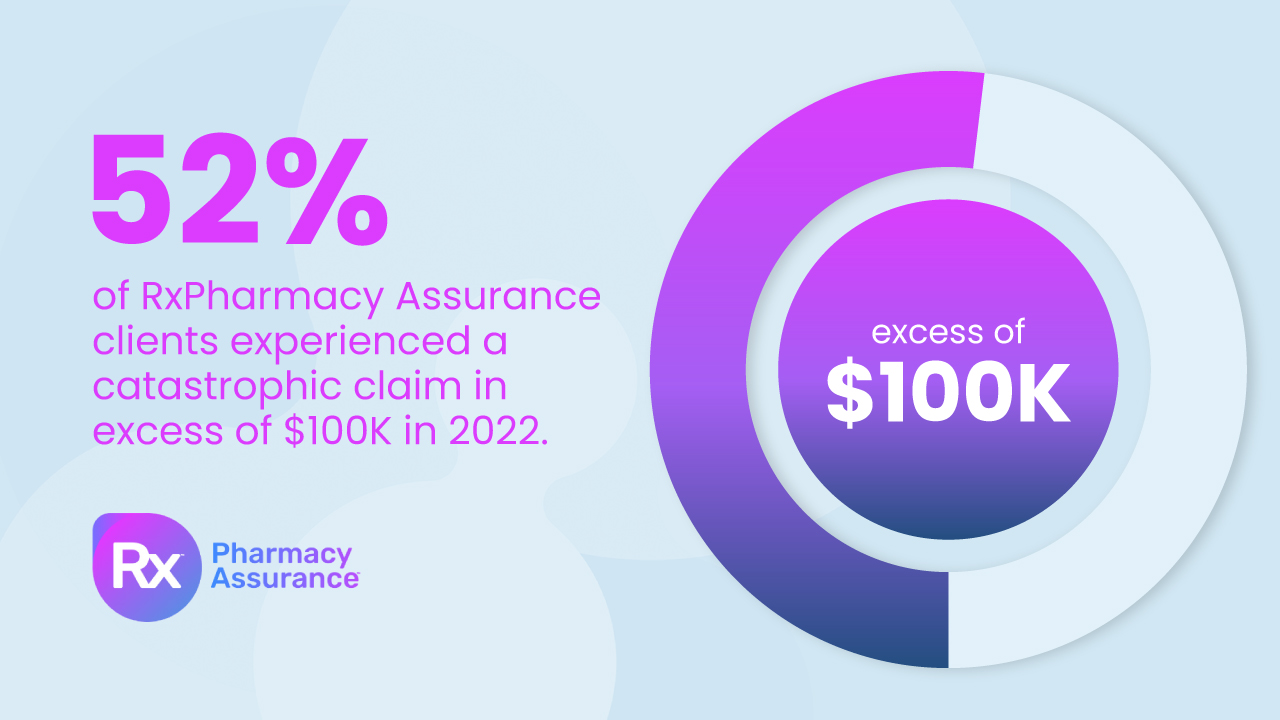
Self-funded plans, particularly when modeled and managed effectively, can substantially reduce costs for employers. When paired with stop-loss insurance to protect against large medical and pharmacy claims their coverage model becomes stronger and costs become more predictable.
While less than 2% of the population uses specialty drugs, these prescriptions account for 55% of total pharmacy spending. Now that these multi-year specialty drug claims are more common, employers are finding traditional stop-loss wasn’t created to weather these types of reoccurring high-cost prescriptions.
In 2022 alone, 52% of RxBenefits clients experienced a claim in excess of $100K, and 15% experienced a claim of $250K or more. Many of these prescriptions treat chronic conditions. While the member gets much needed relief, the multiple years of expensive claims can be budget-breaking and devastating for self-funded employers.
Traditional and supplemental stop-loss attachment points work in tandem
With traditional stop-loss insurance, a self-insured employer pays the cost of the claim up to a contracted attachment point where reimbursement from the carrier kicks in. This provides important protection, but it has limitations. For instance, self-funded employers can find themselves exposed to massive rate increases or lasering after the first year of coverage, increasing the cost and risk for the employer. Simply put, self-funded employers need additional protection for large specialty pharmacy claims.
Attachment points for supplemental stop-loss insurance should be well thought out to minimize the risk of gaps in coverage or unexpected costs created by their traditional stop-loss policy. Attachment points can vary and are negotiated between the insurer and self-insured employer. Therefore, it’s important to understand the needs and risk tolerance of a self-funded employer before enlisting protection.
Determining the best attachment point for your employer client
Understanding the amount of risk your self-insured employer client is comfortable taking on is critical to helping them make a decision on an insurance policy. Insurance policies are not one-size-fits-all. Self-insured employers need flexible protection when it comes to stop-loss in the same way they need flexibility to manage pharmacy benefits. This means selecting a supplemental stop-loss insurance provider that offers a choice of various attachment points to meet each client’s unique needs.
When guiding your self-insured client through the contracting process, start by determining how much the client is able to pay for a high-cost specialty pharmacy claim without reimbursement. If your client has a lower risk tolerance and anticipates higher plan utilization, they may want to consider paying a higher premium for a lower attachment point.
Advise your client to plan for the unexpected. Catastrophic claims can hit a self-funded employer unexpectedly whether it’s a new hire, new diagnosis, new medication, or a number of other common claim risks.
Flexible supplemental stop-loss insurance options
RxPharmacy Assurance strives to meet the unique needs of self-funded employers. That’s why we offer attachment points as low as $100K, with a maximum payout of $1M per year, per condition, per claimant, and up to $3M per condition, per claimant lifetime to make coverage more accessible and flexible for your clients. With RxPharmacy Assurance, more employers are able to choose the coverage that is right for them while effectively removing the volatility associated with high-cost specialty claims — making utilization more certain and predictable.
To get this kind of flexibility for your self-insured clients, contact us today to get a full understanding of our supplemental stop-loss solution, how it works, and the benefits it can provide to self-funded employers of all sizes.

